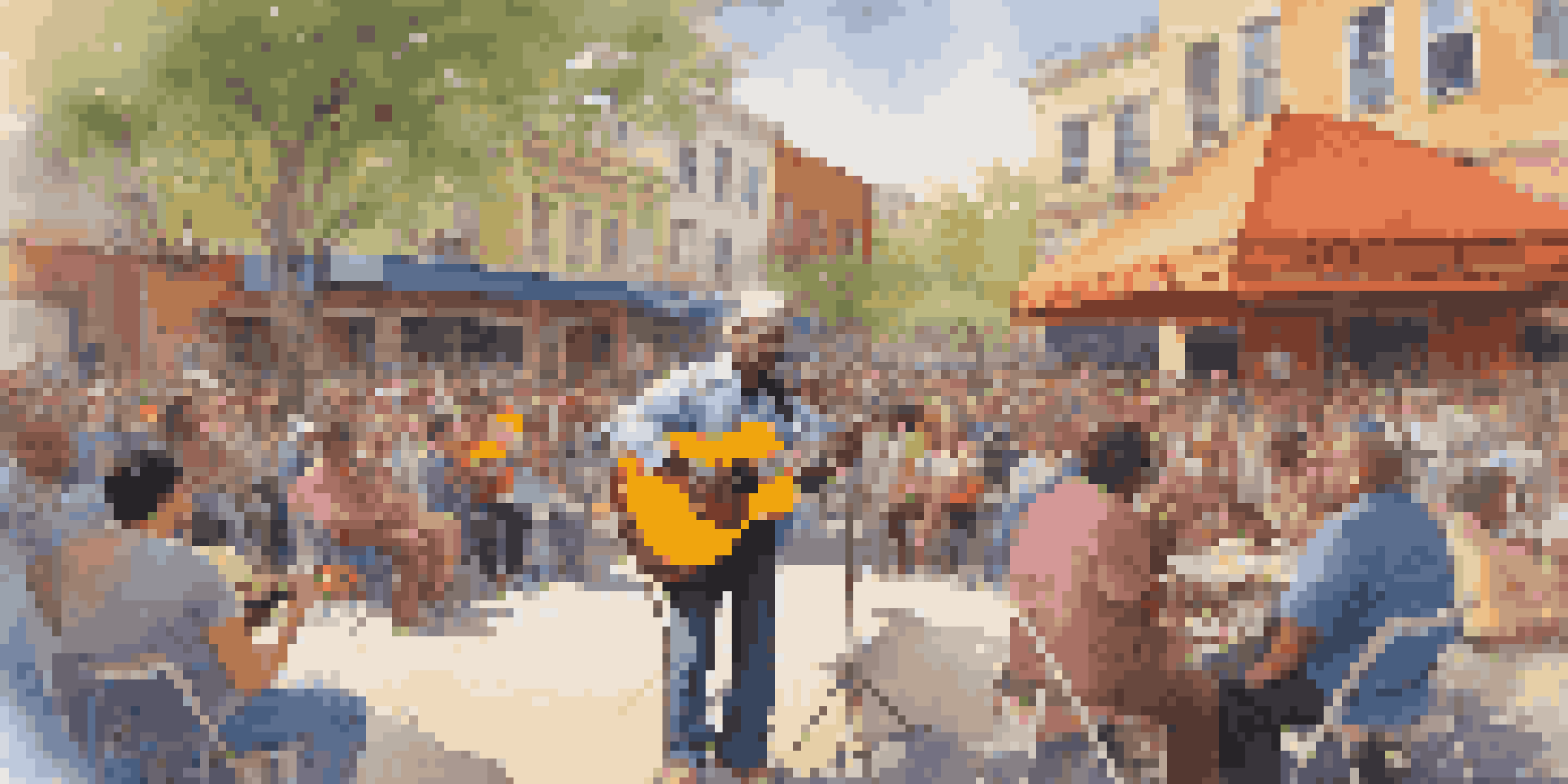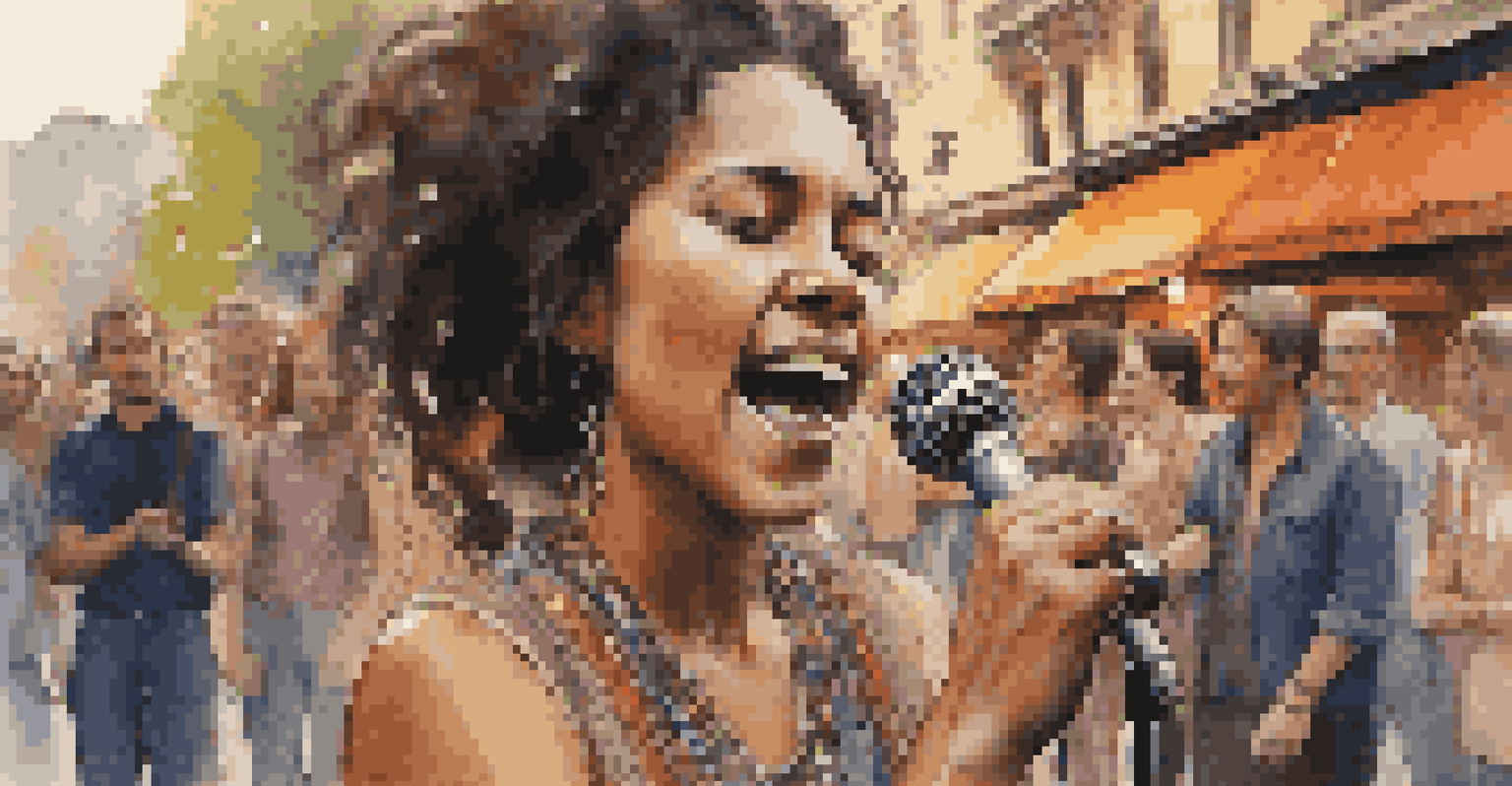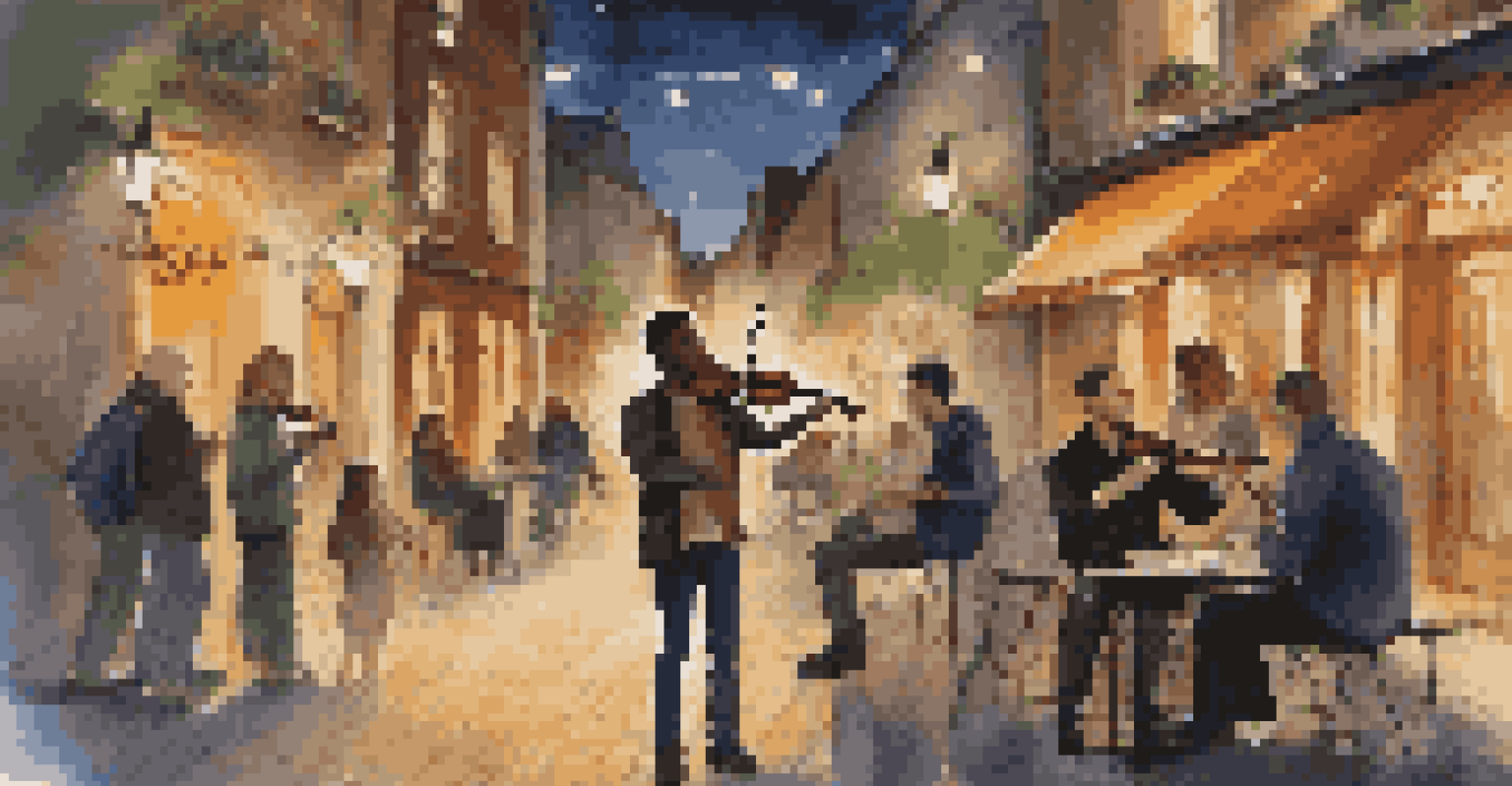Street Music: A Voice for the Marginalized in Conflicts

The Role of Street Music in Conflict Zones
Street music serves as a powerful form of expression, especially in conflict zones. Musicians take to the streets to share their stories, reflecting the struggles and resilience of their communities. This form of art transcends barriers, uniting people through shared experiences and emotions. In areas torn by conflict, street musicians become both witnesses and participants in the fight for justice and peace.
Music can change the world because it can change people.
When traditional media fails to capture the voices of the marginalized, street music fills the gap. It becomes a platform for those who often feel unheard, allowing them to articulate their pain, hopes, and dreams. This grassroots approach not only amplifies their concerns but also fosters a sense of community and solidarity among listeners. In many ways, it transforms public spaces into forums for social change.
Moreover, street music can be a vital tool for healing in post-conflict scenarios. The act of sharing music invites dialogue and reflection, helping communities process trauma. As musicians play their instruments and sing their songs, they create an atmosphere where individuals can openly discuss their experiences and emotions, paving the way for reconciliation and understanding.
Street Music as a Means of Protest
Throughout history, street music has been a significant element of protest movements. Artists often use their craft to challenge oppressive systems and demand social justice. Whether through poignant lyrics or powerful melodies, these musicians capture the spirit of resistance, inspiring others to stand up for their rights. The very act of playing music in public spaces becomes a form of defiance.

For instance, during the Arab Spring, many street musicians used their art to voice dissent against authoritarian regimes. Their songs became anthems of hope, galvanizing crowds and encouraging people to join the fight for freedom. By harnessing the power of music, these artists created a shared sense of purpose, reminding everyone that they are not alone in their struggles.
Street Music Unites in Conflict Zones
In conflict zones, street music serves as a powerful means of expression, uniting communities through shared stories of struggle and resilience.
This tradition continues today, as street musicians around the world tackle pressing issues like inequality, discrimination, and corruption. Their performances often draw attention to causes that might be overlooked by mainstream media. By bringing these narratives to the streets, musicians not only elevate their messages but also engage a wider audience in critical conversations about social change.
The Emotional Impact of Street Music
Street music has a unique ability to evoke emotions and connect people on a deep level. The rawness of live performance creates an intimate atmosphere that can resonate with listeners in profound ways. When musicians share their stories through song, they forge emotional connections that transcend language and cultural barriers. This shared experience can be particularly healing in times of crisis.
Where words fail, music speaks.
Consider the power of a heartfelt ballad sung in a bustling city square. Passersby may stop, listen, and feel a sense of empathy for the artist’s plight. This spontaneous interaction can foster understanding and compassion, reminding us of our shared humanity. In conflict zones, where despair may feel overwhelming, street music offers a glimmer of hope and a reminder that healing is possible.
Furthermore, the emotional impact of street music can motivate individuals to take action. Many listeners are inspired to engage with social issues after being moved by a performance. Whether it's joining a protest, volunteering, or simply spreading awareness, street music can ignite a passion for change and encourage people to voice their concerns.
Cultural Preservation Through Street Music
In times of conflict, street music plays a crucial role in preserving cultural heritage. Many marginalized communities face the risk of losing their traditions and stories amidst turmoil. Musicians help keep these narratives alive by incorporating local languages, instruments, and styles into their performances. This act of cultural preservation not only honors the past but also strengthens community identity.
Take, for example, the vibrant sounds of Afrobeat in Nigeria. Street musicians often blend traditional rhythms with contemporary influences, creating a dynamic musical landscape. By doing so, they celebrate their cultural roots while also addressing current socio-political issues. This fusion of old and new not only captivates audiences but also educates them about the rich history of their people.
Music as a Tool for Protest
Historically, street music has been a vital element of protest movements, allowing artists to challenge oppression and inspire collective action.
Moreover, street music serves as a bridge between generations. Older musicians can pass down stories and techniques to younger artists, ensuring that cultural practices are not forgotten. This intergenerational exchange fosters a sense of pride and continuity, empowering communities to reclaim their narratives in the face of adversity.
The Global Influence of Street Music
Street music is a global phenomenon, with diverse expressions found in cities around the world. From the samba rhythms of Brazil to the folk songs of Eastern Europe, each region boasts its own unique style and message. This diversity highlights the universal nature of music as a tool for storytelling and advocacy. No matter where you go, street musicians are often at the forefront of social movements, using their art to connect with the public.
For instance, in cities like Paris and New York, street performers often blend various genres, creating a rich tapestry of sound. This fusion not only reflects the multicultural fabric of these cities but also allows musicians to share their individual experiences. As they perform, they invite audiences to join in the conversation, fostering a sense of community and collaboration.
Additionally, the rise of social media has amplified the reach of street music. Artists can now share their performances online, reaching audiences far beyond their local streets. This digital platform not only expands their influence but also allows for cross-cultural exchanges, inspiring musicians worldwide to use their voices in support of marginalized communities.
Challenges Faced by Street Musicians
Despite the powerful role street music plays in advocating for marginalized voices, musicians often face significant challenges. In many cities, regulations and permits restrict where and how they can perform. These limitations can stifle creativity and hinder the very expression that street music represents. Moreover, police harassment and public disdain can make it difficult for artists to share their work freely.
Financial instability is another pressing issue for street musicians. Many rely on donations and tips, which can be inconsistent, especially in tough economic times. This uncertainty can deter talented individuals from pursuing a career in music, leading to a loss of diverse voices in the arts. The struggle for financial stability often takes away from their ability to focus on their craft.
Cultural Heritage Through Music
Street musicians play a key role in preserving cultural heritage by incorporating local traditions into their performances, fostering community identity.
Additionally, the stigma surrounding street performance can impact how musicians are perceived. Some view them as mere distractions or nuisances rather than artists with important messages. This perception can create barriers to engagement, making it harder for street musicians to connect with audiences and raise awareness about the issues they address.
The Future of Street Music and Advocacy
As we look towards the future, the role of street music in advocating for marginalized voices will likely continue to evolve. With the rise of technology and social media, artists have more tools than ever to share their messages and reach wider audiences. This evolution presents new opportunities for collaboration and innovation, allowing street musicians to experiment with their art and connect with diverse communities.
Moreover, increased awareness of social issues means that street musicians can play an even more critical role in advocacy. As more people recognize the importance of using their voices for change, street music can serve as a rallying point for collective action. By continuing to share their stories and experiences, musicians can inspire others to engage with important causes and fight for equity.

Ultimately, the future of street music lies in its resilience and adaptability. As long as there are stories to tell and injustices to address, street musicians will find a way to express themselves. By harnessing the power of music, they will remain a vital force for change, ensuring that the voices of the marginalized are not only heard but celebrated.